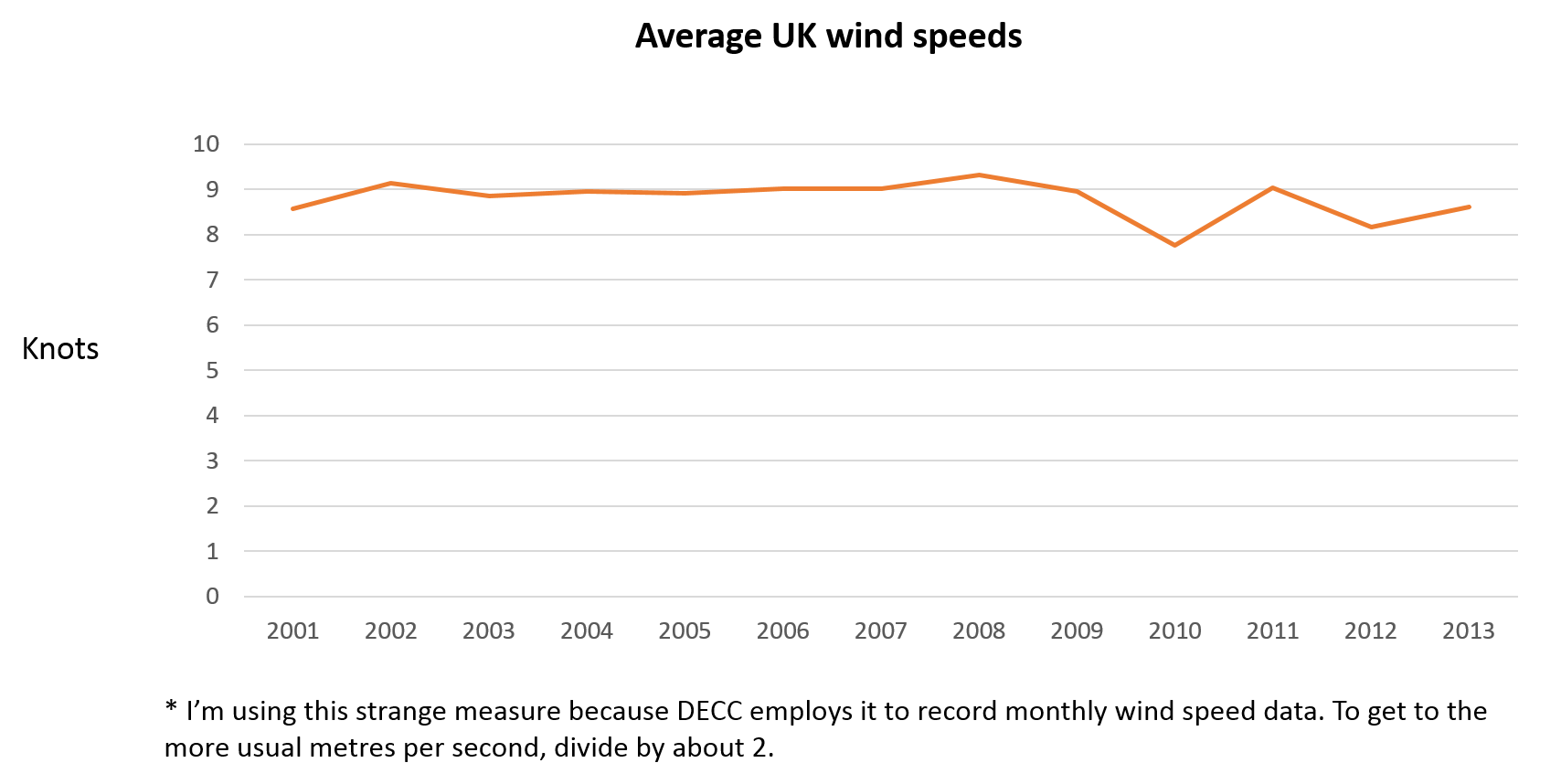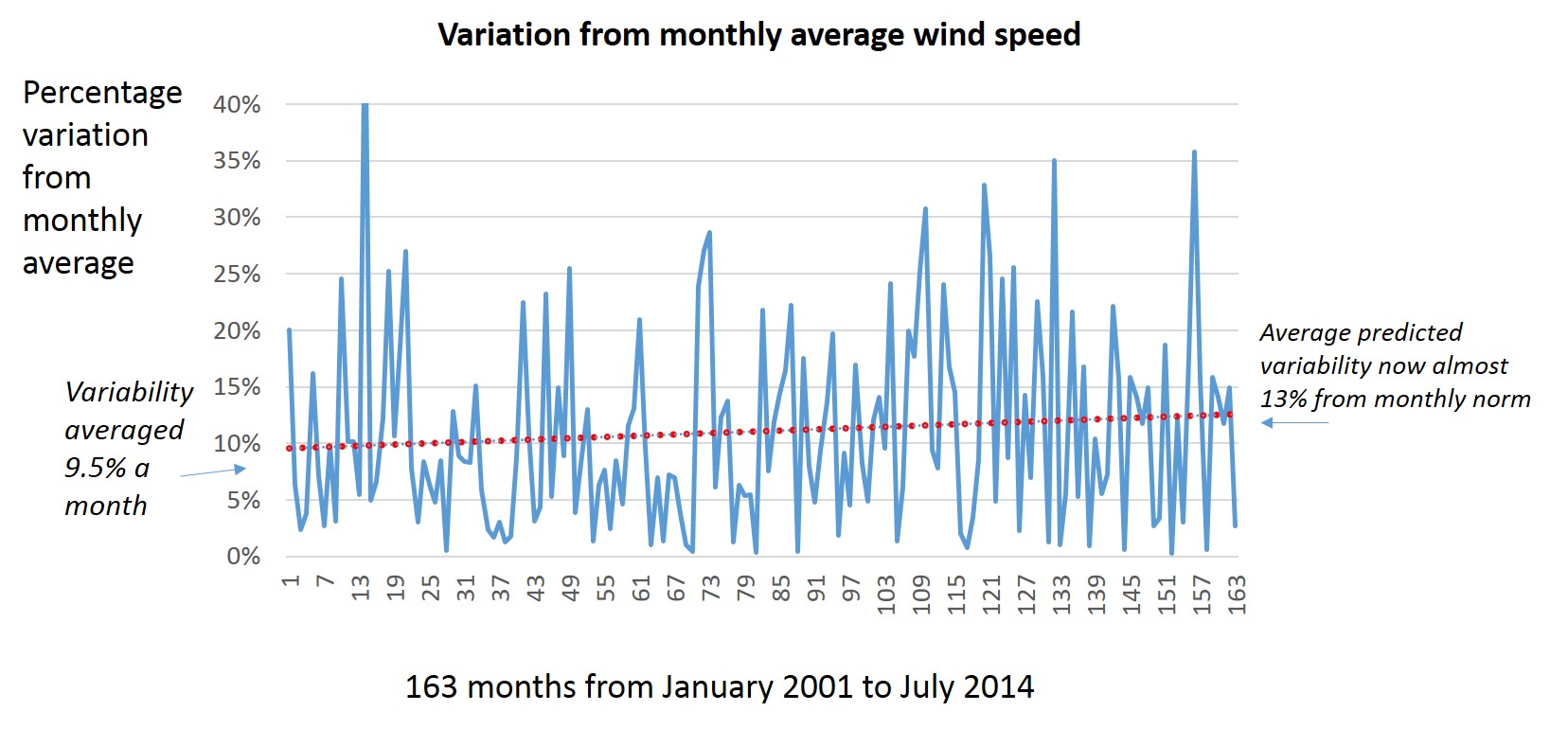Greater wind speed variability adds to the problems of accommodating renewables on the grid
A wind entrepreneur wrote to me last week pointing to the increased variability of wind speeds over the UK. Until recently, he wrote, average monthly wind speeds only very infrequently departed more than 30% from the norm from the month. In the last year, however, he said that we’ve had two months of very high speeds (more than 30% greater than the monthly average) and one very low speed period (30% less than the average for the month). This matters; greater variability of output from wind turbines means more need for backup resources. Does the data match the entrepreneur’s instinct that variability is increasing? A quick look at average wind speeds since the beginning of 2001 argues it does. The average month now varies about 13% from the norm, up from 9.5% in 2001. This isn’t a large amount, and the data doesn’t suggest a very clear trend, but if variability is increasing it will add to future problems balancing UK electricity supply. And higher winter wind speeds will cause more destruction, as they did over many parts of the UK in February of this year.
Wind speeds
The yearly average wind speed across the UK is about 9 knots, or nautical miles per hour. It doesn’t vary greatly from year to year, and there’s certainly no sign of increasing speeds even though more extreme weather is often said to be a consequence of a hotter atmosphere. If anything, the last few years have been below the long-run average.
Over the course of the year, speeds vary fairly predictably from month to month. Winter is windier than summer. The differences don’t look huge with winter speeds typically about 10 knots and summer averaging 8. But because the energy in the wind is the cube of the speed, a typical winter’s day will generate twice as much electricity as a day in the summer.
From the point of view of the people running the electricity grid, really high speeds aren’t necessarily much use. Above a certain speed, turbines don’t actually generate any more power, and will switch themselves off in the strongest gales. Very high wind power output also tends to produce marked instability in the wholesale price of power. The high winds of early August produced negative power prices for several hours. We can see the enormous impact of varying wind speeds most easily in Germany where wholesale prices are now frequently pushed down close to zero.
Variability
DECC produces a monthly summary of average wind speeds.
I plotted the variabililty of the monthly wind speed from the beginning of 2001. I did this by expressing individual months as a percentage of the monthly average (2002-2011). If a month had an average speed of 12 knots, and the month’s typical figure is 10 knots, then I wrote this down as a 20% variation. A speed of 8 knots would also be a 20% variation from the average. (Note: all variations are therefore expressed as positive numbers).
A simple trend line plotted across the 163 months of data suggests that the average variability at the beginning of the period was 9.5%. That is, the average month departed - positively or negatively -about 9.5% from the month’s norm. This figure rose to about 13% in 2014. The correlation isn’t strong. In fact it is lamentably weak and this result has no statistical validity whatsoever. Nevertheless, anyone looking at the numbers will notice that only a third of months varied by more than 10% from the monthly average in the first six years of the series but this number rose to over a half in the second six years. The strong winds of August 2014, which aren’t plotted yet, will have added to the increasing apparent variability.
A very quick analysis of rainfall data shows the same pattern. Monthly rainfall figures typically diverged about 27% from the ten year average for that month in 2001 but this rose to around 32% by 2013. Once again, the data really isn’t robust but the trend is nevertheless quite sharp.
Average wind speeds and rainfall volumes are typical climate data. The ‘noise’ in the figures is an order of magnitude greater than the ‘signal’. As a result, it will be many years before we can be statistically sure monthly average wind speeds are becoming less predictable. This is one of the problems with other impacts of climate change. By the time statisticians have sufficient proof, the impacts will be blindingly obvious.


